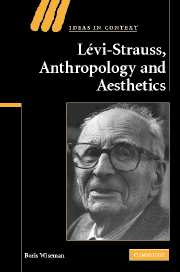Book contents
- Frontmatter
- Contents
- List of illustrations
- Acknowledgements
- Introduction: ethno-aesthetics
- 1 The reconciliation
- 2 Art and the logic of sensible qualities
- 3 The work of art as a system of signs
- 4 Structuralism, Symbolist poetics and abstract art
- 5 The anthropologist as art critic
- 6 Nature, culture, chance
- 7 From myth to music
- 8 Lévi-Strauss's mytho-poem
- Conclusion: between concept and metaphor
- References
- Index
- IDEAS IN CONTEXT
Introduction: ethno-aesthetics
Published online by Cambridge University Press: 27 October 2009
- Frontmatter
- Contents
- List of illustrations
- Acknowledgements
- Introduction: ethno-aesthetics
- 1 The reconciliation
- 2 Art and the logic of sensible qualities
- 3 The work of art as a system of signs
- 4 Structuralism, Symbolist poetics and abstract art
- 5 The anthropologist as art critic
- 6 Nature, culture, chance
- 7 From myth to music
- 8 Lévi-Strauss's mytho-poem
- Conclusion: between concept and metaphor
- References
- Index
- IDEAS IN CONTEXT
Summary
When Claude Lévi-Strauss was a child, his father, Raymond Lévi-Strauss, a portraitist and genre painter whose works were exhibited in the Salons de Paris in the early part of the twentieth century, gave his son a Japanese etching. The young boy used it to adorn the bottom of a box. Later, when he was old enough to be given pocket-money, he would spend it on miniature items of furniture bought from a Parisian shop called The Pagoda. Little by little, he assembled, in his box, a miniature Japanese house. Lévi-Strauss (2003) tells the story himself, age 77, adding that the etching is still in his possession – carefully preserved like the memory itself.
The significance of this biographeme is perhaps best viewed in the light of a passing comment made by Baudelaire in his essay ‘A Philosophy of Toys’, itself the recollection of a childhood memory but also a meditation on the role of the imagination in aesthetic perception. The essay, which in many ways anticipates future psychoanalytic insights into the importance of a child's play, is about the way in which children create imaginary worlds by acting on and through their toys. All children, Baudelaire remarks, talk to their toys. Baudelaire, who was fascinated by toy shops – ‘Is not the whole of life to be found there in miniature – and far more highly coloured?’ (Baudelaire 2003c: 199) – presents the child's relationship to his toys as a prototype of the adult's relationship to the work of art.
- Type
- Chapter
- Information
- Levi-Strauss, Anthropology, and Aesthetics , pp. 1 - 32Publisher: Cambridge University PressPrint publication year: 2007



